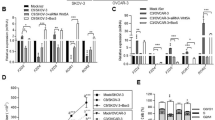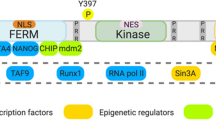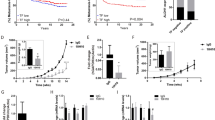Abstract
Interactions between ovarian cancer cells and the surrounding tumor microenvironment are not well characterized. We have earlier shown that ovarian cancer ascites induces Akt activation and protect tumor cells from TRAIL-induced apoptosis. Here, we investigated the mechanism by which ascites activates Akt. The ability of ovarian cancer ascites to activate Akt and inhibit TRAIL-induced cell death and caspase activity was decreased by heat inactivation, but was retained in ascites fractions >5 kDa. The survival promoting activity of ascites was not affected by inhibitors of growth factor receptor including epidermal growth factor receptor (EGFR), VEGFR, FGFR, Her2/neu, and IGF-R1. However, this activity was inhibited by an αvβ5 integrin-blocking antibody, but not by blocking antibodies against αvβ3, β1, or β3 integrins. αvβ5 integrin-blocking antibodies also inhibited ascites-induced Akt phosphorylation and c-FLIPs up-regulation. Ovarian cancer ascites induced a rapid phosphorylation of focal adhesion kinase (FAK), which closely correlated with the phosphorylation of Akt overtime. FAK phosphorylation was strongly inhibited by αvβ5 integrin-blocking antibodies. Depletion of FAK content by RNA interference was also associated with inhibition of ascites-mediated Akt activation and survival. These results suggest that ovarian cancer ascites induces FAK and Akt activation in an αvβ5 integrin-dependent pathway, which confers protection from TRAIL-induced cell death and caspase activation.
This is a preview of subscription content, access via your institution
Access options
Subscribe to this journal
Receive 50 print issues and online access
$259.00 per year
only $5.18 per issue
Buy this article
- Purchase on Springer Link
- Instant access to full article PDF
Prices may be subject to local taxes which are calculated during checkout









Similar content being viewed by others
References
Abendstein B, Stadimann S, Knabbe C, Buck M, Muller-Holzner E, Zeimet AG et al. (2000). Regulation of transforming growth factor-beta secretion by human peritoneal mesothelial and ovarian carcinoma cells. Cytokine 12: 1115–1119.
Alper O, Bergmann-Leitner ES, Bennett TA, Hacker NF, Stromberg K, Stetler-Stevenson WG . (2001). Epidermal growth factor receptor signaling and the invasive phenotype of ovarian carcinoma cells. J Natl Cancer Inst 93: 1375–1384.
Carreiras F, Rigot V, Cruet S, Andre F, Gauduchon P, Marvaldi J . (1999). Migration properties of the human ovarian adenocarcinoma cell line IGROV1: importance of alpha(v)beta3 integrins and vitronectin. Int J Cancer 80: 285–294.
Contos JJ, Ishii I, Chun J . (2000). Lysophosphatidic acid receptors. Mol Pharmacol 58: 1188–1196.
Cruet-Hennequart S, Maubant S, Luis J, Gauduchon P, Staedel C, Dedhar S . (2003). Alpha(v) integrins regulate cell proliferation through integrin-linked kinase (ILK) in ovarian cancer cells. Oncogene 22: 1688–1702.
Damiano JS . (2002). Integrins as novel drug targets for overcoming innate drug resistance. Curr Cancer Drug Targets 2: 37–43.
Dan HC, Jiang K, Coppola D, Hamilton A, Nicosia SV, Sebti SM et al. (2004). Phosphatidylinositol-3-OH kinase/AKT and survivin pathways as critical targets for geranylgeranyltransferase I inhibitor-induced apoptosis. Oncogene 23: 706–715.
Davidson B, Espina V, Steinberg SM, Florenes VA, Liotta LA, Kristensen GB et al. (2006). Proteomic analysis of malignant ovarian cancer effusions as a tool for biologic and prognostic profiling. Clin Cancer Res 12: 791–799.
Fornaro M, Plescia J, Chheang S, Tallini G, Zhu Y-M, King M et al. (2003). Fibronectin protects prostate cancer cells from tumor necrosis factor-alpha-induced apoptosis via the AKT/survivin pathway. J Biol Chem 278: 50402–50411.
Fraser M, Leung BM, Yan X, Dan HC, Cheng JQ, Tsang BK . (2003). Akt-mediated cisplatin resistance in ovarian cancer: modulation of p53 action on caspase-dependent mitochondrial death pathway. Cancer Res 63: 7081–7088.
Frisch SM, Ruoslahti E . (1997). Integrins and anoikis. Curr Opin Cell Biol 9: 701–706.
Goetzl EJ, Dolezalova H, Kong Y, HU Y-L, Jaffe RB, Kalli KR et al. (1999). Distinctive expression and functions of the type 4 endothelial differentiation gene-encoded G protein-coupled receptor for lysophosphatidic acid in ovarian cancer. Cancer Res 59: 5370–5375.
Gillan L, Matei D, Fishman DA, Gerbin CS, Karlan BY, Chang DD . (2002). Periostin secreted by epithelial ovarian carcinoma is a ligand for αvβ3 and αvβ5 integrins and promotes cell motility. Cancer Res 62: 5358–5364.
Graves LE, Ariztia EV, Navari JR, Matzel HJ, Stack S, Fishman DA . (2004). Proinvasive properties of ovarian cancer ascites-derived membrane vesicles. Cancer Res 64: 7045–7049.
Hynes RO . (1992). Integrins: versatility, modulation, and signaling in cell adhesion. Cell 69: 11–25.
Kandasamy K, Srivastava RK . (2002). Role of the phosphatidylinositol 3′-kinase/PTEN/Akt kinase pathway in tumor necrosis factor-related apoptosis-inducing ligand-induced apoptosis in non-small cell lung cancer cells. Cancer Res 62: 4929–4937.
Kang YC, Kim KM, Lee KS, Namkoong S, Lee SJ, Han JA et al. (2004). Serum bioactive lysophospholipids prevent TRAIL-induced apoptosis via PI3K/Akt-dependent cFLIP expression and Bad phosphorylation. Cell Death Differ 11: 1287–1298.
Kobayashi-Sakamoto M, Isogai E, Hirose K, Chiba I . (2008). Role of αv integrin in osteoprotegerin-induced endothelial cell migration and proliferation. Microvasc Res 76: 139–144.
Kohler M, Janz I, Winter HO, Wagner E, Bauknecht T . (1989). The expression of EGF receptors, EGF-like factors and c-myc in ovarian and cervical carcinomas and their potential clinical significance. Anticancer Res 9: 1537–1547.
Kohler M, Bauknecht T, Grimm M, Birmelin G, Kommoss F, Wagner E . (1992). Epidermal growth factor receptor and transforming growth factor alpha expression in human ovarian carcinomas. Eur J Cancer 28: 1432–1437.
Lane D, Robert V, Grondin R, Rancourt C, Piché A . (2007). Malignant ascites protect against TRAIL-induced apoptosis by activating the PI3K/Akt pathway in human ovarian cancer cells. Int J Cancer 121: 1227–1237.
Lane D, Cartier A, Rancourt R, Piché A . (2008). Cell detachment modulates TRAIL resistance in ovarian cancer cells by downregulating the phosphatidylinositol 3-kinase/Akt pathway. Int J Gynecol Oncol 18: 670–676.
Matei D, Emerson RE, Lai Y-C, Baldridge LA, Rao J, Yiannoutsos C et al. (2006). Autocrine activation of PDGFRalpha promotes the progression of ovarian cancer. Oncogene 25: 2060–2069.
Matter ML, Ruoslahti E . (2001). A signaling pathway from the alpha5beta1 and alpha(v)beta3 integrins that elevates bcl-2 transcription. J Biol Chem 276: 27757–27763.
Mills GB, May C, McGill M, Rofiman CM, Mellors A . (1988). A putative new growth factor in ascitic fluid from ovarian cancer patients: identification, characterization, and mechanism of action. Cancer Res 48: 1066–1071.
Mills GB, Moolenaar WH . (2003). The emerging role of lysophosphatidic acid in cancer. Nat Rev Cancer 3: 582–591.
Miyamoto S, Hirata M, Yamazaki A, Kageyama T, Hasuwa H, Mizushima H et al. (2004). Heparin-binding EGF-like growth factor is a promising target for ovarian cancer therapy. Cancer Res 64: 5720–5727.
Noguchi K, Ishii S, Shimizu T . (2003). Identification of p2y9/GPR23 as a novel G protein-coupled receptor for lysophosphatidic acid, structurally distant from the Edg family. J Biol Chem 278: 25600–25606.
Puiffe M-L, Le Page C, Filali-Mouhim A, Zietarska M, Ouellet V, Tonin PN et al. (2007). Characterization of ovarian cancer ascites on cell invasion, proliferation, spheroid formation, and gene expression in an in vitro model of epithelial ovarian cancer. Neoplasia 9: 820–829.
Puls LE, Duniho T, Hunter JE, Kryscho R, Blackhurst D, Gallion H . (1996). The prognostic implication of ascites in advanced-stage ovarian cancer. Gynecol Oncol 61: 109–112.
Ren J, Xiao Y-J, Singh LS, Zhao X, Zhao Z, Feng L et al. (2006). Lysophosphatidic acid is constitutively produced by human peritoneal mesothelial cells and enhances adhesion, migration, and invasion of ovarian cancer cells. Cancer Res 66: 3006–3014.
Saltzman AK, Hartenbach EM, Carter JR, Contreras DN, Twiggs LB, Carson LF et al. (1999). Transforming growth factor-alpha levels in the serum and ascites of patients with advanced epithelial ovarian cancer. Gynecol Obstet Invest 47: 200–204.
Shen-Gunther J, Mannel RS . (2002). Ascites as a predictor of ovarian malignancy. Gynecol Oncol 87: 77–83.
Sivaprasad U, Shankar E, Basu A . (2007). Downregulation of Bid is associated with PKCepsilon-mediated TRAIL resistance. Cell Death Differ 14: 851–860.
Stoica A, Saceda M, Fakhro A, Joyner M, Martin MB . (2000). Role of insulin-like growth factor-I in regulating estrogen receptor-alpha gene expression. J Cell Biochem 76: 605–614.
Stupack DG, Cheresh DA . (2002). Get a ligand, get a life: integrins, signaling and cell survival. J Cell Science 115: 3729–3738.
Uhm JH, Dooley NP, Kyritsis AP, Rao JS . (1999). Vitronectin, a glioma-derived extracellular matrix protein, protects tumor cells from apoptotic death. Clin Cancer Res 5: 1587–1594.
Westermann AM, Havik E, Postma FR, Beijenen JH, Dalesio O, Moolenaar WH et al. (1998). Malignant effusions contain lysophosphatidic acid (LPA)-like activity. Ann Oncol 9: 437–442.
Yamada T, Sato K, Komachi M, Malchinkhuu E, Tobo M, Kimura T et al. (2004). Lysophosphatidic acid (LPA) in malignant ascites stimulates motility of human pancreatic cancer cells through LPA1. J Biol Chem 279: 6595–6605.
Yang X, Fraser M, Moll UM, Basak A, Tsang BK . (2006). Akt-mediated cisplatin resistance in ovarian cancer: modulation of p53 action on caspase-dependent mitochondrial death pathway. Cancer Res 66: 3126–3136.
Yarden Y, Sliwkowski MX . (2001). Untangling the ErbB signalling network. Nat Rev Mol Cell Biol 2: 127–137.
Ye X, Ishii I, Kingsbury MA, Chun J . (2002). Lysophosphatidic acid as a novel cell survival/apoptotic factor. Biochim Biophys Acta 1585: 108–113.
Zhang Z, Vuori K, Reed JC, Ruslahti E . (1995). The alpha 5 beta 1 integrin supports survival of cells on fibronectin and up-regulates Bcl-2 expression. Proc Natl Acad Sci USA 92: 6161–6165.
Acknowledgements
Funding for this study was provided by the Cancer Research Society. We thank the Tumor Bank from the ‘Réseau de Recherche en Cancer du Fond de Recherche en Santé du Québec’ for providing the ovarian cancer ascites.
Author information
Authors and Affiliations
Corresponding author
Ethics declarations
Competing interests
The authors declare no conflict of interest.
Additional information
Supplementary Information accompanies the paper on the Oncogene website
Rights and permissions
About this article
Cite this article
Lane, D., Goncharenko-Khaider, N., Rancourt, C. et al. Ovarian cancer ascites protects from TRAIL-induced cell death through αvβ5 integrin-mediated focal adhesion kinase and Akt activation. Oncogene 29, 3519–3531 (2010). https://doi.org/10.1038/onc.2010.107
Received:
Revised:
Accepted:
Published:
Issue Date:
DOI: https://doi.org/10.1038/onc.2010.107
Keywords
This article is cited by
-
MAP kinase ERK5 modulates cancer cell sensitivity to extrinsic apoptosis induced by death-receptor agonists
Cell Death & Disease (2023)
-
Choline kinase alpha impairment overcomes TRAIL resistance in ovarian cancer cells
Journal of Experimental & Clinical Cancer Research (2021)
-
TRAIL receptor-induced features of epithelial-to-mesenchymal transition increase tumour phenotypic heterogeneity: potential cell survival mechanisms
British Journal of Cancer (2021)
-
Ascites from ovarian cancer patients stimulates MUC16 mucin expression and secretion in human peritoneal mesothelial cells through an Akt-dependent pathway
BMC Cancer (2019)
-
Malignant ascites-derived organoid (MADO) cultures for gastric cancer in vitro modelling and drug screening
Journal of Cancer Research and Clinical Oncology (2019)



